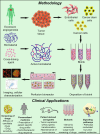3D tumor angiogenesis models: recent advances and challenges
- PMID: 34613483
- PMCID: PMC8557138
- DOI: 10.1007/s00432-021-03814-0
3D tumor angiogenesis models: recent advances and challenges
Abstract
The development of blood vessels, referred to as angiogenesis, is an intricate process regulated spatially and temporally through a delicate balance between the qualitative and quantitative expression of pro and anti-angiogenic molecules. As angiogenesis is a prerequisite for solid tumors to grow and metastasize, a variety of tumor angiogenesis models have been formulated to better understand the underlying mechanisms and associated clinical applications. Studies have demonstrated independent mechanisms inducing angiogenesis in tumors such as (a) HIF-1/VEGF mediated paracrine interactions between a cancer cell and endothelial cells, (b) recruitment of progenitor endothelial cells, and (c) vasculogenic mimicry. Moreover, single-cell sequencing technologies have indicated endothelial cell heterogeneity among organ systems including tumor tissues. However, existing angiogenesis models often rely upon normal endothelial cells which significantly differ from tumor endothelial cells exhibiting distinct (epi)genetic and metabolic signatures. Besides, the existence of intra-individual variations necessitates the development of improved tumor vascular model systems for personalized medicine. In the present review, we summarize recent advancements of 3D tumor vascular model systems which include (a) tissue engineering-based tumor models; (b) vascular organoid models, and (c) organ-on-chips and their importance in replicating the tumor angiogenesis along with the associated challenges to design improved models.
Keywords: 3D model systems; Organ on chip; Organoid models; Tumor angiogenesis.
© 2021. The Author(s).
Conflict of interest statement
The authors have no conflicts of interest to declare that are relevant to the content of this article.
Figures


References
-
- Aharonov O, Maftzir G, Benezra D (1993) The role of cytokines in angiogenesis. Ocul Immunol Inflamm 1:135–142. 10.3109/09273949309086550 - PubMed
-
- Ana M, Lao KH, Zeng L (2017) Angiogenesis and cardiovascular diseases: the emerging role of HDACs, physiologic and pathologic angiogenesis - signaling mechanisms and targeted therapy.
-
- Aplin AC, Nicosia RF (2016) The aortic ring assay and its use for the study of tumor angiogenesis. Methods Mol Biol 1464:63–72. 10.1007/978-1-4939-3999-2_6 - PubMed
Publication types
MeSH terms
LinkOut - more resources
Full Text Sources
Medical
Research Materials

